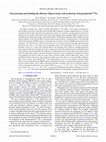Papers by Bastiaan Driehuys

Magnetic resonance in medicine : official journal of the Society of Magnetic Resonance in Medicine / Society of Magnetic Resonance in Medicine, Jan 18, 2015
We sought to develop and test a clinically feasible 1-point Dixon, three-dimensional (3D) radial ... more We sought to develop and test a clinically feasible 1-point Dixon, three-dimensional (3D) radial acquisition strategy to create isotropic 3D MR images of (129) Xe in the airspaces, barrier, and red blood cells (RBCs) in a single breath. The approach was evaluated in healthy volunteers and subjects with idiopathic pulmonary fibrosis (IPF). A calibration scan determined the echo time at which (129) Xe in RBCs and barrier were 90° out of phase. At this TE, interleaved dissolved and gas-phase images were acquired using a 3D radial acquisition and were reconstructed separately using the NUFFT algorithm. The dissolved-phase image was phase-shifted to cast RBC and barrier signal into the real and imaginary channels such that the image-derived RBC:barrier ratio matched that from spectroscopy. The RBC and barrier images were further corrected for regional field inhomogeneity using a phase map created from the gas-phase (129) Xe image. Healthy volunteers exhibited largely uniform (129) Xe-bar...
A98. NANOTECH MEETS THE LUNG, 2012
Magnetic Resonance Imaging Clinics of North America, 2015
Functional imaging offers information more sensitive to changes in lung structure and function. H... more Functional imaging offers information more sensitive to changes in lung structure and function. Hyperpolarized helium ((3)He) and xenon ((129)Xe) MR imaging of the lungs provides sensitive contrast mechanisms to probe changes in pulmonary ventilation, microstructure, and gas exchange. Gas imaging has shifted to the use of (129)Xe. Xenon is well-tolerated. (129)Xe is soluble in pulmonary tissue, which allows exploring specific lung function characteristics involved in gas exchange and alveolar oxygenation. Hyperpolarized gases and (129)Xe in particular stand to be an excellent probe of pulmonary structure and function, and provide sensitive and noninvasive biomarkers for pulmonary diseases.
D99. THE FUTURE IS NOW: ADVANCED IMAGING OF LUNG STRUCTURE AND FUNCTION, 2010
D99 THE FUTURE IS NOW: ADVANCED IMAGING OF LUNG STRUCTURE AND FUNCTION May 19/1:30 PM-4:00 PM / R... more D99 THE FUTURE IS NOW: ADVANCED IMAGING OF LUNG STRUCTURE AND FUNCTION May 19/1:30 PM-4:00 PM / Room 228-230 (Second Level), Morial Convention Center ... 3He And 1He MRI Imaging Of Regional Pulmonary Injury In House-Dust-Mite Allergic Mice
B98. NOVEL APPROACHES TO LUNG IMAGING, 2011
Radiology, 1996
Two healthy volunteers who had inhaled approximately 0.75 L of laser-polarized helium-3 gas under... more Two healthy volunteers who had inhaled approximately 0.75 L of laser-polarized helium-3 gas underwent magnetic resonance imaging at 1.5 T with fast gradient-echo pulse sequences and small flip angles ( < 10 degrees). Thick-section (20 mm) coronal images, time-course data (30 images collected every 1.8 seconds), and thin-section (6 mm) images were acquired. Subjects were able to breathe the gas (12% polarization) without difficulty. Thick-section images were of good quality and had a signal-to-noise ratio (S/N) of 32:1 near the surface coil and 16:1 farther away. The time images showed regional differences, which indicated potential value for quantitation. High-resolution images showed greater detail and a S/N of approximately 6:1.

Physical review. A, Jan 6, 2014
The ability to produce liter volumes of highly spin-polarized (129)Xe enables a wide range of inv... more The ability to produce liter volumes of highly spin-polarized (129)Xe enables a wide range of investigations, most notably in the fields of materials science and biomedical MRI. However, for nearly all polarizers built to date, both peak (129)Xe polarization and the rate at which it is produced fall far below those predicted by the standard model of Rb metal vapor, spin-exchange optical pumping (SEOP). In this work, we comprehensively characterized a high-volume, flow-through (129)Xe polarizer using three different SEOP cells with internal volumes of 100, 200 and 300 cc and two types of optical sources: a broad-spectrum 111-W laser (FWHM = 1.92 nm) and a line-narrowed 71-W laser (FWHM = 0.39 nm). By measuring (129)Xe polarization as a function of gas flow rate, we extracted peak polarization and polarization production rate across a wide range of laser absorption levels. Peak polarization for all cells consistently remained a factor of 2-3 times lower than predicted at all absorptio...
Radiology, 1996
The authors imaged the lungs of live guinea pigs with hyperpolarized (HP) helium-3 as a magnetic ... more The authors imaged the lungs of live guinea pigs with hyperpolarized (HP) helium-3 as a magnetic resonance (MR) signal source. HP He-3 gas produced through spin exchange with rubidium metal vapor was delivered through an MR-compatible, small-animal ventilator. Two- and three-dimensional lung images acquired with ventilation-gated, radial k-space sampling showed complete ventilation of both lungs. All images were of high quality, demonstrating that HP He-3 allows high-signal-intensity MR imaging in living systems.
D30. NOVEL APPROACHES TO ASSESSING LUNG PATHOPHYSIOLOGY, 2012
D99. THE FUTURE IS NOW: ADVANCED IMAGING OF LUNG STRUCTURE AND FUNCTION, 2010
D99 THE FUTURE IS NOW: ADVANCED IMAGING OF LUNG STRUCTURE AND FUNCTION May 19/1:30 PM-4:00 PM / R... more D99 THE FUTURE IS NOW: ADVANCED IMAGING OF LUNG STRUCTURE AND FUNCTION May 19/1:30 PM-4:00 PM / Room 228-230 (Second Level), Morial Convention Center ... Hyperpolarized 129Xe MR Imaging Of Alveolar-Capillary Gas Transfer In Healthy Subjects And COPD ...
B70. FINE ANALYSIS OF ALVEOLAR/AIRWAY STRUCTURE AND FUNCTION, 2010
B70 FINE ANALYSIS OF ALVEOLAR/AIRWAY STRUCTURE AND FUNCTION AM-4:00 PM / Area K, Hall G (First Le... more B70 FINE ANALYSIS OF ALVEOLAR/AIRWAY STRUCTURE AND FUNCTION AM-4:00 PM / Area K, Hall G (First Level), Morial Convention Center ... Diffusion Weighted Imaging Of Hyperpolarized 129Xe In Patients With Chronic Obstructive Pulmonary Disease

Academic radiology, 2014
Clinical deployment of hyperpolarized (129)Xe magnetic resonance imaging requires accurate quanti... more Clinical deployment of hyperpolarized (129)Xe magnetic resonance imaging requires accurate quantification and visualization of the ventilation defect percentage (VDP). Here, we improve the robustness of our previous semiautomated analysis method to reduce operator dependence, correct for B1 inhomogeneity and vascular structures, and extend the analysis to display multiple intensity clusters. Two segmentation methods were compared-a seeded region-growing method, previously validated by expert reader scoring, and a new linear-binning method that corrects the effects of bias field and vascular structures. The new method removes nearly all operator interventions by rescaling the (129)Xe magnetic resonance images to the 99th percentile of the cumulative distribution and applying fixed thresholds to classify (129)Xe voxels into four clusters: defect, low, medium, and high intensity. The methods were applied to 24 subjects including patients with chronic obstructive pulmonary disease (n = ...







Uploads
Papers by Bastiaan Driehuys